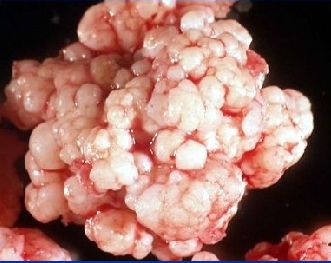
Tumor benigno que contiene hueso y cartílago. Este tipo de tumor habitualmente se presenta en los extremos de los huesos largos de los brazos y las piernas, o en la pelvis o el hombro. Puede causar un crecimiento anormal de los brazos, las manos y las piernas; problemas para mover las articulaciones, y dolor, adormecimiento y cosquilleo. Puede haber uno o más tumores; en algunas familias se presentan tumores múltiples. Los osteocondromas se pueden presentar en algún momento después de un tratamiento para el cáncer, como un trasplante de células madre.
<(A.): Osteochondrom, osteokartilaginäre Exostose: ist die häufigste skelettale Neubildung. Der knorpelüberzogene subperiostale Knochenvorsprung macht 20-50 % der gutartigen Knochentumoren und 10-15 % aller Knochentumoren aus. Osteochondrome treten am häufigsten in den ersten beiden Lebensjahrzehnten auf mit einem Verhältnis von Männern zu Frauen von 1,5 zu 1. Osteochondrome finden sich am häufigsten in den langen Knochen, insbesondere im distalen Femur und in der proximalen Tibia, wobei 40 % der Tumoren um das Knie herum auftreten.
<(F.): Ostéochondrome, exostose ostéogénique: variété de tumeur bénigne du squelette, unique ou multiple, implantée à la surface de l'os.
<(In.): Osteochondroma, osteocartilaginous exostosis: is the most common skeletal neoplasm. The cartilage capped subperiosteal bone projection accounts for 20-50% of benign bone tumors and 10-15% of all bone tumors. Osteochondromas occur most frequently in the first two decades of life with a ratio of male to female of 1.5 to 1. Osteochondromas are found most often in long bones, especially the distal femur and proximal tibia, with 40% of the tumors occurring around the knee.
BUSCADORES EN CIENCIAS DE LA SALUD:
INFORMACIÓN PACIENTES:
-
WIKIPEDIA (E)
TEXTOS:
TÉRMINOS RELACIONADOS:
